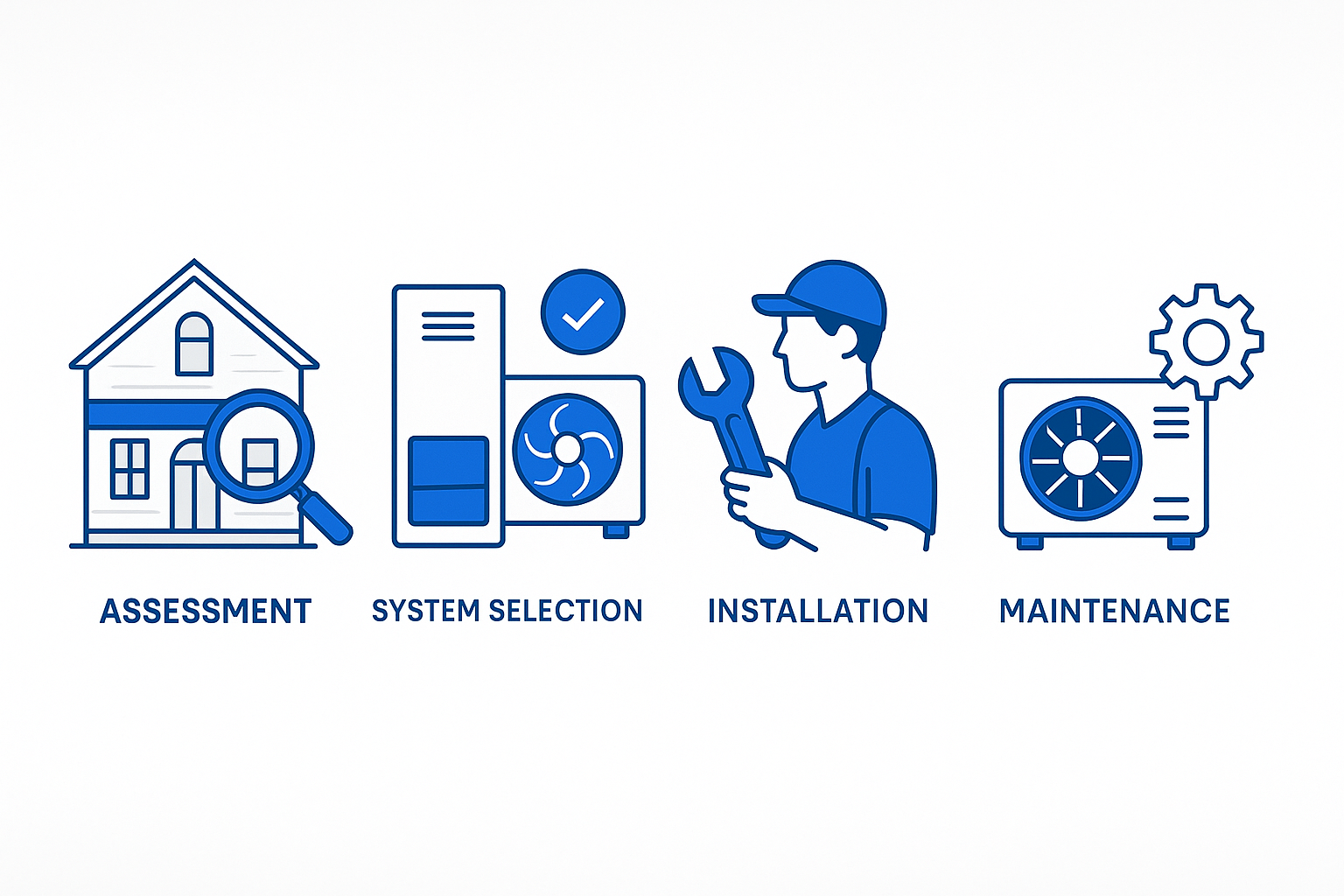
Energy-Efficient HVAC Retrofitting for Historic Long Island City Homes
Table of Contents
Benefits of Energy-Efficient Retrofits

In the heart of Long Island City, interest in energy-efficient HVAC retrofitting for historic Long Island City homes is rapidly rising, as homeowners seek to blend modern comfort with preservation. These upgrades not only offer substantial cost savings, reducing typical energy bills by 15-30%, but also significantly improve home value and environmental impact. Choosing a provider familiar with the unique challenges of high-density, historic urban neighborhoods ensures a seamless experience that honors both the past and the future.
Historic home retrofits require specialized systems–like Ductless Mini-Split Systems, high-velocity HVAC systems, and geothermal heat pumps–to balance performance with preservation. Integrating new technologies such as smart thermostats integration brings advanced control and flexibility, furthering energy savings and delivering day-to-day convenience for residents of historic Long Island City homes.
1. Lower Energy Bills Significantly
The primary motivation behind energy-efficient HVAC retrofitting is the promise of substantial energy bills reduction. Studies and case examples in LIC demonstrate that after retrofitting, historic homes regularly achieve energy savings of 20%-30%. Upgrading from outdated boilers or air conditioning units to advanced systems like Electric Heat Pumps and mini-splits can drastically curb monthly costs.
Energy retrofits are not just about replacement–they also include improving building insulation and integrating smart thermostats, both of which are proven to amplify efficiency results. Homeowners benefit as much from reduced utility expenses as from a heightened sense of control, especially when monitoring systems remotely–an innovation steadily growing across Long Island City. For those considering home refurbishments, Hvac Contractor Long Island City NY often recommends starting with an energy assessment before making strategic upgrades.
2. Specialized Systems for Historic Homes
Every historic property presents its own set of architectural challenges. Fortunately, modern Ductless Mini-Split Systems offer a flexible and minimally invasive way to provide targeted heating or cooling to specific zones, without the need for large-scale ductwork. This makes them particularly suited for historic home HVAC retrofits, where original design elements must remain undisturbed.
Additionally, high-velocity HVAC systems use small, flexible ducts installed within existing walls to preserve even the most intricate trim or plasterwork, providing powerful performance with subtle impacts. For homeowners seeking sustainable, long-term solutions, geothermal heat pumps harness ground temperatures for ultra-efficient climate control, supporting both eco-goals and comfort throughout the changing New York seasons.
3. Preserving Historic Integrity
A successful HVAC retrofit in a heritage residence fundamentally respects original architecture. Through the use of non-invasive solutions like mini-splits and high-velocity ductwork, homeowners ensure structural preservation while reaping the benefits of modern comfort. Following carefully crafted local preservation guidelines and collaborating with experienced specialists–a hallmark of Astoria Top HVAC–ensures compliance as well as optimal performance.
“Preservation and performance can coexist. The best HVAC retrofits blend invisible efficiency with historically respectful installation, keeping the beauty of Long Island City homes intact for future generations.”
With choices such as smart thermostats, retrofits can be tailored to the home’s unique needs while safeguarding its visual and architectural legacy. Hvac Contractors Long Island City who specialize in historic upgrades are essential in balancing aesthetics and technology.
4. Local Incentives and Rebates
For homeowners committed to energy-efficient HVAC retrofitting for historic Long Island City homes, a variety of city and utility rebates are available. Local HVAC incentives help offset much of the initial investment, especially for projects involving heat pumps and smart controls.
New York City incentive programs typically support substantial upgrades, making energy-saving technology more accessible. The application process often involves coordinating with certified contractors, who guide filings and ensure proper documentation. For updated program details, established Heating And Air Contractors Long Island City are the most reliable source of current incentives in LIC.
5. Retrofit Process Timelines
The HVAC retrofit timeline for historic homes is structured but flexible, depending on building size and chosen systems. Typically, a thorough assessment and permitting phase are followed by system design. Minimally invasive systems like mini-splits can be installed within days for each zone, with broader projects averaging 4-8 weeks from assessment to completion.
Contractors emphasize careful coordination with preservation authorities to avoid delays and ensure all work meets code. Clear communication throughout keeps homeowners informed, while strategic planning reduces project duration and maintains the home’s integrity. Hvac Contractor Long Island City NY notes that phased execution allows families to remain comfortably at home even as upgrades occur.
6. Comparing Astoria Top HVAC Expertise
Astoria Top HVAC stands out for its legacy of serving LIC and Astoria’s historic neighborhoods with deep local knowledge and commitment to quality. Their expertise in minimally invasive installations and meticulous system planning–especially for brownstones and pre-war residences–means homeowners can trust both the efficiency of their systems and the preservation of their property’s character. The team’s meticulous craftsmanship is complemented by advanced energy-saving recommendations including tailored maintenance, smart integration, and prompt emergency support unique to the area.
The company’s standing among Heating And Air Contractors Long Island City and among all Hvac Contractors Long Island City is reflected in numerous positive testimonials and repeat business, making them the top choice for homeowners prioritizing heritage as much as comfort.
7. Choosing the Right Contractor
Selecting Heating And Air Contractors Long Island City with extensive experience in historic home retrofits is crucial. Qualified contractors should have certifications, verified customer reviews, and strong communication skills. Their familiarity with local regulations, preservation guidelines, and modern technology integration ensures a smooth and durable result.
It’s vital to request detailed project proposals and clear timeframes. Contractors such as Astoria Top HVAC offer transparent pricing, industry certifications, and comprehensive aftercare plans. Their reputation for professionalism and adaptability is one reason why Heating And Air Contractors Long Island City remain in demand throughout the borough. For many, the search for Hvac Contractors Long Island City truly begins and ends with proven expertise and customer-first service.
Ensuring Efficient Retrofits Success
Summing up, energy-efficient HVAC retrofitting in Long Island City’s historic homes delivers lower energy costs, improved comfort, and a stronger local property market. By leveraging energy-efficient HVAC retrofitting for historic Long Island City homes, homeowners enjoy unique solutions that preserve architecture while maximizing modern efficiency–with the right contractor at the helm.
Choosing Astoria Top HVAC ensures your project receives unparalleled craftsmanship and access to the latest HVAC technologies. As leading Heating And Air Contractors Long Island City, their local expertise supports every phase, from eligibility for rebates to seamless installation and attentive maintenance. Let expert Hvac Contractor Long Island City NY guide your journey to sustainable comfort–because in Long Island City, home heritage and innovation are always in balance.
Resources
Premier Ductless Mini Split Installation in Long Island City, NY 11109
Electric Heat Pumps Get Warm Reviews Queens Public Housing Development
Astoria Top HVAC
Furnace Repair Near Me NY
Furnace Repair Brooklyn Heights NY
Furnace Repair Upper East Side NY
HVAC Brooklyn Heights
